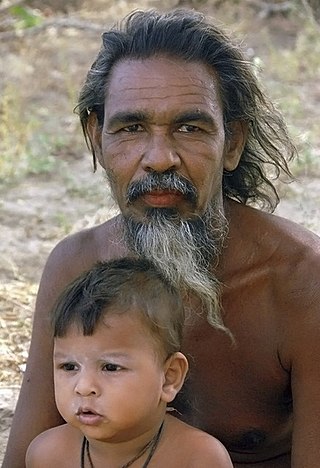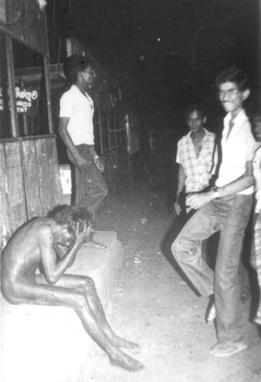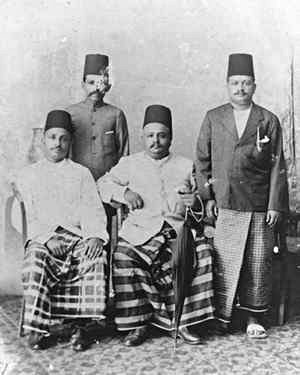Related Research Articles

The history of Sri Lanka is unique because its relevance and richness extend beyond the areas of South Asia, Southeast Asia and the Indian Ocean. The early human remains which were found on the island of Sri Lanka date back to about 38,000 years ago.

The Vedda, or Wanniyalaeto, are a minority indigenous group of people in Sri Lanka who, among other sub-communities such as Coast Veddas, Anuradhapura Veddas and Bintenne Veddas, are accorded indigenous status. The Vedda minority in Sri Lanka may become completely assimilated. Most speak Sinhala instead of their indigenous languages, which are nearing extinction. It has been hypothesized that the Vedda were probably the earliest inhabitants of Sri Lanka and have lived on the island since before the arrival of other groups from the Indian mainland.

Provinces are the first level administrative divisions of Sri Lanka. Currently, Sri Lanka is divided into 9 provinces. Each province is further divided into districts, which are further divided into divisional secretariats.

Junius Richard Jayewardene, commonly abbreviated in Sri Lanka as J.R., was a Sri Lankan lawyer, public official and statesman who served as Prime Minister of Sri Lanka from 1977 to 1978 and as the second President of Sri Lanka from 1978 to 1989. He was a leader of the nationalist movement in Ceylon who served in a variety of cabinet positions in the decades following independence. A longtime member of the United National Party, he led it to a landslide victory in the 1977 parliamentary elections and served as prime minister for half a year before becoming the country's first executive president under an amended constitution.
The caste systems in Sri Lanka are social stratification systems found among the ethnic groups of the island since ancient times. The models are similar to those found in Continental India, but are less extensive and important for various reasons. Modern times Sri Lanka is often considered to be a casteless society in south asia.

Black July was an anti-Tamil pogrom that occurred in Sri Lanka during July 1983. The pogrom was premeditated, and was finally triggered by a deadly ambush on a Sri Lankan Army patrol by the Liberation Tigers of Tamil Eelam (LTTE) on 23 July 1983, which killed 13 soldiers. Although initially orchestrated by members of the ruling UNP, the pogrom soon escalated into mass violence with significant public participation.
Sri Lankan Chetties also known as Colombo Chetties, are an ethnicity in the island of Sri Lanka. Before 2001, they were known as the Sri Lankan Tamil caste, but then after 2001, they were classified as a separate ethnic group in the 2001 census. They are now collectively referred to as the Colombo Chetties. They were said to have migrated from India under Portuguese rule and were given special rights and representation during colonial rule.
Bharatha People also known as Bharatakula and Paravar, is an ethnicity in the island of Sri Lanka. Earlier considered a caste of the Sri Lankan Tamils, they were classified as separate ethnic group in the 2001 census. They are descendant of Tamil speaking Paravar of Southern India who migrated to Sri Lanka under Portuguese rule. They live mainly on the western coast of Sri Lanka and mainly found in the cities of Mannar, Negombo and Colombo.
Negombo Tamils or Puttalam Tamils are the Tamil speaking ethnic Karavas who live in the western Gampaha and Puttalam districts of Sri Lanka. They are distinguished from other Tamils from the island nation by their unique dialects, one of which is known as Negombo Tamil dialect. Other sub categories of native Tamils of Sri Lanka are Jaffna Tamils or Northern Tamils and Batticalao Tamils or Eastern Tamils from the traditional Tamil dominant North and East of the Island nation. Negombo is a principal coastal city in the Gampaha District and Puttalam is also the principal city within the neighbouring Puttalam District.

Sri Lankan Moors are an ethnic minority group in Sri Lanka, comprising 9.3% of the country's total population. Most of them are native speakers of the Tamil language. The majority of Moors who are not native to the North and East also speak Sinhalese as a second language. They are predominantly followers of Islam. The Sri Lankan Muslim community is mostly divided between Sri Lankan Moors, Indian Moors, Sri Lankan Malays and Sri Lankan Bohras. These groups are differentiated by lineage, language, history, culture and traditions.
Sri Lankan state-sponsored colonization schemes is the government program of settling mostly Sinhalese farmers from the densely populated wet zone into the sparsely populated areas of the dry zone. This has taken place since the 1950s near tanks and reservoirs being built in major irrigation and hydro-power programs such as the Mahaweli project.

Sri Lankan place name etymology is characterized by the linguistic and ethnic diversity of the island of Sri Lanka through the ages and the position of the country in the centre of ancient and medieval sea trade routes. While typical Sri Lankan placenames of Sinhalese origin vastly dominate, toponyms which stem from Tamil, Dutch, English, Portuguese and Arabic also exist. In the past, the many composite or hybrid place names and the juxtaposition of Sinhala and Tamil placenames reflected the coexistence of people of both language groups. Today, however, toponyms and their etymologies are a source of heated political debate in the country as part of the political struggles between the majority Sinhalese and minority Sri Lankan Tamils.

British Ceylon, officially British Settlements and Territories in the Island of Ceylon with its Dependencies from 1802 to 1833, then the Island of Ceylon and its Territories and Dependencies from 1833 to 1931 and finally the Island of Ceylon and its Dependencies from 1931 to 1948, was the British Crown colony of present-day Sri Lanka between 1796 and 4 February 1948. Initially, the area it covered did not include the Kingdom of Kandy, which was a protectorate, but from 1817 to 1948 the British possessions included the whole island of Ceylon, now the nation of Sri Lanka.
Sri Lankan Tamil nationalism is the conviction of the Sri Lankan Tamil people, a minority ethnic group in the South Asian island country of Sri Lanka, that they have the right to constitute an independent or autonomous political community. This idea has not always existed. Sri Lankan Tamil national awareness began during the era of British rule during the nineteenth century, as Tamil Hindu revivalists tried to counter Protestant missionary activity. The revivalists, led by Arumuga Navalar, used literacy as a tool to spread Hinduism and its principles.
Vedda is an endangered language that is used by the indigenous Vedda people of Sri Lanka. Additionally, communities such as Coast Veddas and Anuradhapura Veddas who do not strictly identify as Veddas also use words from the Vedda language in part for communication during hunting and/or for religious chants, throughout the island.
Social class in Sri Lanka is often described as casteless, though caste is still found on the island in both a symbolic and a practical sense. Caste is also used in an analogous sense to refer to the new social class divisions that have appeared in recent decades. The combination of ethnic nationalist movements that saw caste as an island-wide dividing tool, strong emphasis on providing access to education and healthcare regardless of background, and historic lack of discrimination among the colonial civil service played a factor in eradicating the caste system in most sectors of the island's society. Although the Buddhist culture actively fought against all forms of class discrimination, many Buddhist organizations used caste as a method to extract surplus from temple property.

The Coast Veddas, by self-designation, form a social group within the minority Sri Lankan Tamil ethnic group of the Eastern province of Sri Lanka. They are primarily found in small coastal villages from the eastern township of Trincomalee to Batticalao. Nevertheless, they also inhabit a few villages south of Batticalao as well. They make a living by fishing, slash and burn agriculture, paddy cultivation of rice, basket weaving for market and occasional wage labor. Anthropologists consider them to be partly descended from the indigenous Vedda people, as well as local Tamils. Residents of the Eastern province consider their Vedar neighbors to have been part of the local social structure from earliest times, whereas some Vedar elders believe that their ancestors may have migrated from the interior at some time in the past.
Indians in Sri Lanka refer to Indians or people of Indian ancestry living in Sri Lanka, such as the Indian Tamils of Sri Lanka.

Tamil settlement of Sri Lanka refers to the settlement of Tamils, or other Dravidian peoples, from Southern India to Sri Lanka. Due to Sri Lanka's close proximity to Southern India, Dravidian influence on Sri Lanka has been very active since the early Iron Age or megalithic period.
The Jayewardene family is a Sri Lankan family that is prominent in law and politics. Along with many members who have been successful politician across generations, the family includes Presidents and Prime Ministers of Sri Lanka.
References
- ↑ Susantha Goonetilleke, Sinhalisation: Migration or Cultural Colonization? Lanka Guardian Vol. 3, No. I, May I, 1980, pp. 22-29, and May 15 1980, pp. 18-19.
- ↑ Power and Religiosity in a Post-Colonial Setting: Sinhala Catholics in Contemporary Sri Lanka by R. L. Stirrat American Ethnologist, Vol. 22, No. 2 (May, 1995), pp. 428-429
- ↑ Buddhism Betrayed?: Religion, Politics, and Violence in Sri Lanka By Stanley Jeyaraja Tambiah, p. 152-3
- ↑ A SHORT HISTORY OF LANKA by Humphry William Codrington, CHAPTER I; THE BEGINNINGS 'The princess and her retinue/dowry (service castes)'
- ↑ 'Pandyan retinue of Prince Vijaya': Sea: Our Saviour By K. Sridharan, p.19
- ↑ Pre-Vijayan Agriculture in Sri Lanka, by Prof. T. W. Wikramanayake
- ↑ Kshatriya, GK (December 1995). "Genetic affinities of Sri Lankan populations". Hum. Biol. 67 (6): 843–66. PMID 8543296.
- ↑ Mitochondrial DNA history of Sri Lankan ethnic people: their relations within the island and with the Indian subcontinental populations, L Ranaweera, et al; Journal of Human Genetics (2014)
- 1 2 Nilaperumal Kalukapuge aka Badaranayaka
- ↑ J.R. Jayawardena family History of the Colombo Chetties, edited and compiled by Deshabandu Reggie Candappa, Reviewed by Anne Abayasekara (Sunday Times, 08.07.2001)
- ↑ Pilimatalavuva - Family, roots.web, Accessed 13-06-2015
- ↑ "How it Came to This – Learning from Sri Lanka's Civil Wars By Professor John Richardson" (PDF). paradisepoisoned.com. Retrieved 30 March 2006.
- ↑ "Ethnic Identity, National Identity and the Search for Unity" (PDF). World Council of Churches. Retrieved 30 March 2006.
- ↑ "Significance of the abortive 1962 military coup". Hindustan Times. Retrieved 30 March 2006.
- ↑ "The Human Rights and Humanitarian Fallout from the Sri Lankan Government's Eastern Agenda and the LTTE's Obduracy". UTHR . Retrieved 30 March 2006.
- ↑ Short, Damien, ed. (2016). Redefining Genocide: Settler Colonialism, Social Death and Ecocide. London, UK: Zed Books. pp. 93–126. ISBN 978-1-84277-930-9.
- ↑ "TamilNet: 23.04.13 Indian news magazine highlights accelerated Sinhalization of Tamil north". UTHR . Retrieved 23 April 2013.
- ↑ "Exclusive: Erasing the cultural leftover of Tamils to convert Sri Lanka into Sinhala country". UTHR . Retrieved 23 April 2013.
- ↑ "New military colonies in Murukandi; Sinhalization in Puthumathalan". UTHR . Retrieved 23 April 2013.
- ↑ "Salt on Old Wounds: The systematic Sinhalization of Sri Lanka's North, East, the historic habitat of the Tamil speaking people". UTHR . Retrieved 23 April 2013.
- ↑ Pilimatalavuva Family by Ananda Pilimatalavuva, 05-08-2019